Physical Address
304 North Cardinal St.
Dorchester Center, MA 02124
The multitude of respiratory complications caused by smoke inhalation, flame burns, and their treatment epitomize the clinical challenges that confront health care workers. Smoke inhalation injury and its sequelae impose demands on the practitioners who play a central role in its clinical management. These demands may range from intubation and resuscitation of victims in the emergency room to assistance with diagnostic bronchoscopies, performance of pulmonary function studies, monitoring of arterial blood gases, airway maintenance, chest physiotherapy, and mechanical ventilator management. Additional demands are placed on the practitioners in the rehabilitation phase in determining disability or limitations diagnosed by pulmonary function studies or cardiopulmonary stress testing. It is imperative that a well-organized, protocol-driven approach to respiratory care of the burn patient be utilized so that improvements can be made and the morbidity and mortality associated with inhalation injury can be reduced ( Box 18.1 ). This chapter provides an overview of the common hands-on approaches to the treatment of inhalation injury, with emphasis on mucociliary clearance techniques, pharmacologic adjuncts, mechanical ventilation, infection control, and the late complications associated with inhalation injury.
Titrate humidified oxygen to maintain S aO 2 s >90%
Cough, deep breath exercises every 2 h
Turn patient side to side every 2 h
Chest physiotherapy every 4 h
Aerosolize 3 cc of 20% N-acetylcysteine every 4 h with a bronchodilator
Alternate aerosolizing 5000 units of heparin with 3 cc of normal saline every 4 h
Nasotracheal suctioning as needed
Early ambulation on postoperative day 5
Sputum cultures for intubated patients every M-W-F
Pulmonary function studies prior to discharge and at outpatient visits
Patient/family education regarding inhalation injury
The protocol is continued for 7 days.
Airway clearance techniques are an essential component of respiratory management of patients with smoke inhalation. Bronchial hygiene therapy is a term used to describe several of the modalities intended to accomplish this goal. Therapeutic coughing, chest physiotherapy, bronchial drainage and positioning, percussion and vibration, early ambulation, airway suctioning, and therapeutic bronchoscopy have been effective in the removal of retained secretions.
Therapeutic coughing functions to promote airway clearance of excess mucus and fibrin casts in the tracheal bronchial tree. Impairing the cough mechanism may result in retained secretions, bronchial obstruction, atelectasis, and/or pneumonia. A cough can either be a reflex or a voluntary action. The mechanisms of a cough include:
a deep inspiration,
the closure of the glottis,
contraction of the muscles in the chest wall, abdomen, and pelvic floor,
opening of the glottis, and
a rapid expulsive exhalation phase.
During a cough, alveolar, pleural, and subglottic pressures may rise as much as 200 cm H 2 O. A failure of the cough mechanism may be due to an impairment of any step in the sequence described. When this occurs, it is necessary to perform techniques which are used to improve the cough.
The patient is asked to start a small breath and small cough, followed by a bigger breath and harder cough, and finally a very deep breath and hard cough. This technique is particularly effective for postoperative patients who tend to splint from pain.
The respiratory therapist places their index and middle finger flat in the patient's sternal notch and gently massages inward in a circular fashion over the trachea. This is most effective with obtunded patients or with patients recovering from anesthesia.
Patients with artificial airways cannot cough normally since a tube is placed either between their vocal cords (endotracheal tube) or below their cords (tracheostomy). Adequate pressure cannot be built up without the cords in close proximity. A cough may be stimulated by inflating the cuff on the tube, giving a large and rapid inspiration with the manual resuscitation bag, holding the breath for 1–2 s, and rapidly allowing the bag to release and exhalation to ensue. This technique is normally performed by two persons, and it is made more effective with one therapist performing vibration and chest compressions from the time of the inspiratory hold all during exhalation. Cough and deep breathing exercises are encouraged every 2 h to aid in removing retained secretions.
The definition of chest physiotherapy has progressed to gravity-assisted bronchial drainage with chest percussion and vibrations. Studies have shown that the combination of techniques are effective in secretion removal.
Bronchial drainage/positioning is a therapeutic modality that uses gravity-assisted positioning designed to improve pulmonary hygiene in patients with inhalation injury or retained secretions. Studies have shown that a patient's arterial oxygenation may fall during bronchial drainage/positioning. Therefore, it is common practice in intensive care units to turn patients side to side every 2 h to aid in mobilizing secretions ( Fig. 18.1 ).
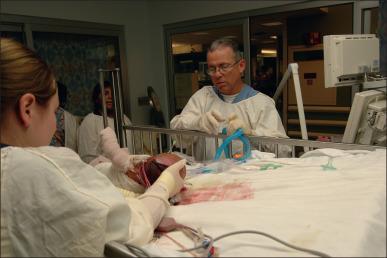
Percussion aids in the removal of secretions from the tracheal bronchial tree. It is performed by cupping the hand to allow a cushion of air to enter between the therapist's hand and the patient. If this is done properly, a popping sound will be heard when the patient is percussed. There should be a towel between the patient and the therapist's hand in order to prevent irritation of the skin. Percussion is applied over the surface landmarks of the bronchial segments that are being drained. The hands rhythmically and alternately strike the chest wall. Incisions, skin grafts, and bony prominences should be avoided during percussion ( Fig. 18.2 ).
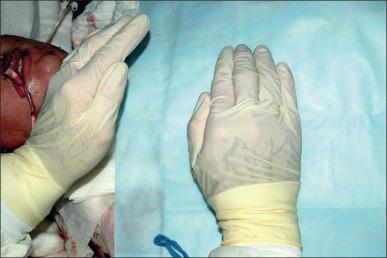
Vibration/shaking is a movement used to move loose secretions to larger airways so that they can be coughed up or removed by suctioning. Vibration involves the rapid shaking of the chest wall during exhalation. The percussor vibrates the thoracic cage by placing both hands over the percussed areas and vibrating into the patient, isometrically contracting or tensing the muscles of their arms and shoulders. Mechanical vibrations have been reported to be clinically effective. Gentle mechanical vibration may be indicated for patients who cannot tolerate manual percussion ( Fig. 18.3 ). Chest physiotherapy techniques should be used every 2–4 h for patients with retained secretions.
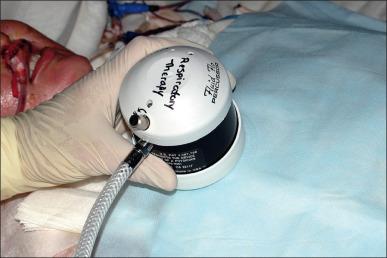
Early ambulation is another effective means of preventing respiratory complications. Patients routinely should be helped out of bed on postoperative days 3–5, and they should be encouraged to ambulate and sit in a chair. With the appropriate use of analgesics, even patients on continuous mechanical ventilation can be helped out of bed and into a chair ( Fig. 18.4 ). The rocking chair ( Fig. 18.5 ) has several beneficial effects:
the patient can breathe with regions of the lungs that are normally hyperventilated,
muscular strength and tone are preserved, and
contractions are prevented and exercise tolerance is maintained.
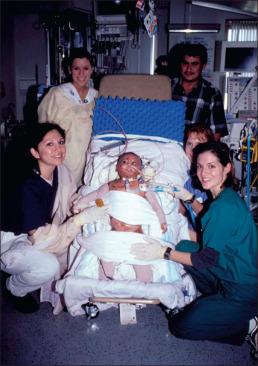
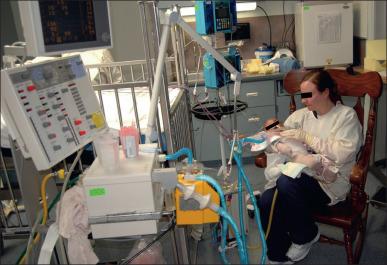
Airway suctioning is another method of clearing an airway. Normal bronchial hygiene is usually accomplished by the mucociliary escalator process. When these processes are not effective in maintaining a clear airway, tracheobronchial suctioning is recommended. Nasotracheal suctioning is intended to remove accumulated secretions and other foreign material from the trachea that cannot be removed by the patient's spontaneous cough or by less invasive procedures. Nasotracheal suctioning refers to the insertion of a suction catheter through the nasal passages and pharynx into the trachea in order to aspirate secretions or foreign material.
The first step in this process is to hyperoxygenate the patient with 100% oxygen. The patient should be positioned in the Fowler's position, and the catheter slowly advanced through the nares to a point just above the larynx. The operator then listens for air sounds at the proximal end of the catheter. When airflow is felt to be strongest and respiratory sounds are loudest, the tip of the catheter is immediately above the epiglottis. On inspiration, the catheter is advanced into the trachea. After the vocal cords have been passed, a few deep breaths are allowed and the patient is reoxygenated. Suction begins while the catheter is slowly withdrawn from the trachea. The patient should not be suctioned for more than 15 s without being reoxygenated.
Suctioning is not without potential hazards. Complications include irritation of the nasotracheal mucosa with bleeding, abrupt drops in P o 2 , vagal stimulation, and bradycardia. Preoxygenating and limiting suction time have been shown to decrease or eliminate the fall in the P o 2 . Sputum cultures should be performed for microbiological identification when they are clinically indicated.
When all other techniques fail to remove secretions, the use of the fiberoptic bronchoscope may be beneficial. In addition to its diagnostic functions, bronchoscopy retains important therapeutic applications. The fiberoptic bronchoscope is small in diameter, flexible, and has a steerable tip that can be maneuvered into the fourth- or fifth-order bronchi for examination or specimen removal. Copious secretions encountered in patients with inhalation injury may require repeated bronchoscopic procedures when more conservative methods are unsuccessful.
Bronchodilators can be helpful in select cases. Inhalation injury to the lower airways results in a chemical tracheobronchitis, which can produce wheezing and bronchospasms. Most drugs used in the management of bronchospasms are believed to control bronchial muscle tone. Aerosolized sympathomimetic are effective in two ways: they cause bronchial muscle relaxation, and they stimulate mucociliary clearance. A newer compound of note is metaproterenol, which is available as a cartridge inhaler, as an aerosolized liquid, as a tabular oral medication, or as a syrup. The recommended oral dose is 10–20 mg every 6–8 h, or 1–2 puffs every 3–4 h as an inhaled bronchodilator with a duration of action of 1–5 h.
Albuterol can also be aerosolized or be administered orally or parenterally. Albuterol is available in a metered cartridge inhaler, and its standard dose is 1–2 puffs three to four times daily. Aerosolized albuterol has a duration of action of approximately 4–6 h.
Racemic epinephrine is used as an aerosolized topical vasoconstrictor, bronchodilator, and secretion bond breaker. The vasoconstrictive action of racemic epinephrine is useful in reducing mucosal and submucosal edema within the walls of the pulmonary airways. A secondary bronchodilator action serves to reduce potential spasms of the smooth muscles of the terminal bronchioles. Water, employed as a diluent for racemic epinephrine, serves to lower both adhesive and cohesive forces of the retained endobronchial secretions, thus serving as a bond-breaking vehicle. Racemic epinephrine has also been used for the treatment of postextubation stridor. Its mode of action is thought to be related to the vasoconstrictive activity, with the resultant decrease in mucosal edema. Aerosolized treatments may be given every 2 h as long as the heart rate is not increased.
Hypertonic saline offers a theoretically more effective form of mucokinetic therapy. The deposition of hypertonic droplets on the respiratory mucosa causes the osmotic attraction of fluids from the mucosal blood vessels and tissues into the airway. Thus, a “bronchorrhea” is induced. The watery solution helps dilute the respiratory tract secretions and increase their bulk, thereby augmenting expectoration. Furthermore, there is evidence that hypertonic saline has a direct effect on the mucoprotein DNA complexes, and, by reducing the cohesive intramolecular forces, the salt helps reduce the viscous properties of the mucoid fluid. Excessive use of hypertonic saline is not recommended because burn patients cannot tolerate the sodium load and may develop edema.
Oxandrolone is a synthetic testosterone analog that has been shown to significantly reduced hypermetabolism and significantly increased height percentile, bone mineral content, lean body mass, and strength in pediatric burn patients. Recently, it has been shown that pediatric patients treated with oxandrolone for 1 year had significantly higher maximum voluntary ventilation compared to untreated patients. Also, during maximal exercise, the subjects treated with oxandrolone had a significantly higher maximal ventilation (V EMax ). The administration of oxandrolone may be used as an agent in the future to improve lung function in burned patients.
Aerosolized acetylcysteine is a powerful mucolytic agent in use in respiratory care. Acetylcysteine contains a thiol group; the free sulfhydryl radical of this group is a strong reducing agent which ruptures the disulfide bonds that give stability to the mucoprotein network. Agents that break down these disulfide bonds produce the most effective mucolysis. Of note, acetylcysteine is an irritant to the respiratory tract. It can cause mucosal changes, and it may induce bronchospasms. For this reason, patients are evaluated for signs of bronchospasms, and a bronchodilator may be added if necessary. Acetylcysteine has proved to be effective in combination with aerosolized heparin for the treatment of inhalation injury in animal studies.
Last, heparin and acetylcysteine combinations have been used as scavengers for the free oxygen radicals produced when alveolar macrophages are activated either directly by chemicals in smoke or by one or more of the compounds in the arachidonic oxidative cascade. Animal studies have shown an increased P/F ratio, decreased peak inspiratory pressures, and a decreased amount of fibrin cast formation with the heparin and acetylcysteine combination therapy. In a retrospective review, Desai et al. have shown that the use of heparin and N-acetylcysteine is effective in pediatric patients with inhalation injury. Results indicated a significant decrease in the reintubation rates, the incidence of atelectasis, and improved mortality for patients treated with the combined therapy. Therefore, a standard treatment for patients with inhalation injury may include 5000–10,000 units of heparin and 3 mL normal saline nebulized every 4 h, alternating with 3–5 mL of 20% acetylcysteine for 7 days. This ensures that the patient receives an aerosolized treatment every 2 h. Baseline and daily clotting analyses are recommended for the entire length of the aerosolized treatments.
Become a Clinical Tree membership for Full access and enjoy Unlimited articles
If you are a member. Log in here